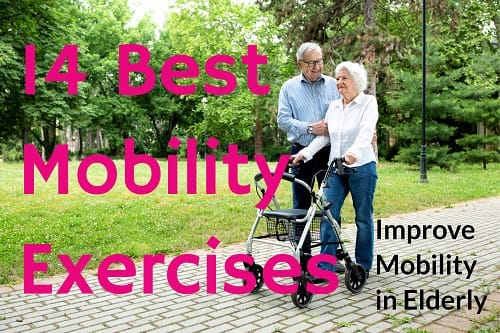Contents
How to Improve Mobility in Elderly – Elderly Mobility Exercises
Even healthy adults lose some flexibility and mobility as they age. But they need not lose these abilities completely. These time-tested elderly mobility exercises show how to improve mobility in elderly people and prevent further loss. Additionally, keeping as active as possible also promotes good physical health and keeps us happier, too.
Indeed, even if your loved one is wheelchair or bedridden, research indicates that daily exercise proves quite beneficial. Physical exercise is vital for seniors because it will help minimize their risk of contracting specific health problems, improve their mood, and keep them healthy.
Many people tend to slow down as they grow older. So, we have gathered the best elderly mobility exercise that will keep your elderly loved ones healthy and active.
Mobility problems can make it difficult for someone to spend time doing things they love, leading to social separation, loneliness, and poor health. When people grow older, they tend to restrict their movements. Often they feel they should do fewer physical activities. However, staying active remains crucial to aging gracefully and staying well.
How important is mobility in older age?
Mobility helps preserve independence, particularly as people age. The lack of mobility creates significant social, psychological, and physical implications for seniors. Muscle weakness and versatility are common causes of these shortcomings.
If joints and muscles cannot adequately handle movements and stresses, immobility causes pain or even fracture. On the other hand, physical activity and fitness eliminates or reduces the harmful consequences of immobility. Regular chores such as getting out of bed and rising from a chair become more challenging if you’re elderly do not exercise regularly.
While movement of any kind helps, using specific elderly mobility exercises ensures a good fitness routine.
What causes us to lose our mobility as we get older?
A variety of causes are involved. Arthritis is one of the most common conditions, but it also begins with fatigue and weakness in the legs due to immobility or reduced mobility.
When do the elderly stretch, and how much?
Stretching for the aged and seniors can be performed two or three times a week, with a 20 to 30-second hold between each stretch. For each body part, try one or two stretches you want to boost your stamina; you can stretch four to five days a week. Do remember to warm up before starting an elderly flexibility workout regimen. Warming up is a perfect way to practice stretching exercises.
Try to stretch 2-5 times a week, depending on the stress and power needs. Set aside between 10-15 minutes per day to do the stretches. They should be careful and take deep breaths while stretching to calm both their bodies and minds.
Also, remember to stretch before performing these elderly mobility exercises. Some enjoy stretching after, too, to keep the muscles limber.
How to improve mobility in the elderly?
There are a lot of ways to help your elderly ones to keep them healthy and fit.
Maintain a healthy weight
One of the most important things you can do to boost your mobility as a senior is to keep a good weight. Having stable legs is essential for having a high degree of mobility. Obesity, for example, will make your elderly legs thin and, as a result, their mobility will suffer a lot. That is why it is so vital to keep a good weight. Here are a few guidelines for maintaining a healthier weight:
- Encourage the elderly to Get 75 minutes of vigorous exercise or 150 minutes of mild exercise each week (or a combination of both)
- Drink plenty of water will increase their stamina, stop headaches, and cleanse their body.
- Consume organic, balanced foods.
- Encourage them to get plenty of rest at night and try to get up and go to bed simultaneously every day.
Proper diet
To keep as fit as possible, your elderly loved one must eat well. People who may not walk around much have lower appetites and may not consume enough vitamins, nutrients, and energy. If your relative has a weak desire, consider luring them in with high-protein snacks and light meals, mainly before they engage in any physical activity.
Fluid consumption is also essential, and the older adult can drink enough of it. It is especially crucial to growing their activity level because they can lose fluid even though they aren’t aware of it. After even light exercise, dehydrated people will suffer pains and cramps and feel exhausted.
Best Elderly Mobility Exercises
Suppose an elderly adult has problems walking around on their own and finding it tough to get even a tiny amount of exercise through the day. In that case, they shouldn’t be bothered because there are still opportunities to exercise without ever having to leave their chair! Chair exercises are an excellent option for senior citizens.
There is no requirement for a weight collection or a trainer, and seniors do not need to accompany by a caregiver at all times. A senior-only requires a chair; however, some of the following exercises can necessitate using a resistance band or dumbbells for reliable performance. Please endure in mind that when it comes to fitness, everyone has varying degrees of relaxation.
1. Balancing Wand
This balance exercise can be performed by seniors while seated. To get around, you’ll need a cane or a rod. It can do with a broomstick; remove the broom’s head before beginning. Make sure the bottom of the stick is level with your palm. This exercise aims to keep the bar upright as long as possible. Turn hands so you can concentrate on all sides of your body’s stance.
2. Calf Stretches
Calf stretches are another elderly mobility exercise for senior people. This old strength conditioning routine can complete either sitting or standing. Find a wall with nothing on it to do calf stretches while standing. Stand with your palms at eye level, facing the wall. Place your left leg in front of your right. Bend your elderly knee while keeping their left foot on the concrete. For 15 to 30 seconds, hold the stretch. Repeat for each leg two or four times.
They will need a towel if they want to stretch their calves while seated. Sit with the legs straight on the concrete. Wrap the towel across the right foot’s soles and cradle both ends. Keep the towel to the knee for 15 to 30 seconds while pulling it towards you. Repeat the exercise two or four times on each leg.
3. Single Limb Stance with Arm
This time-honored juggling exercise strengthens physical balance: request that the seniors stand beside a chair with their feet together and arms at their backs.
Raise their left hand to the chin’s edge. After that, raise the left foot softly off the ground. Hang in that position for ten seconds. On the other side, repeat the process.
4. Back Leg Raises
This old strength conditioning routine strengthens the bottom and lowers back. Place yourself behind a cushion. Lift your right leg straight up slowly, without bending your knees or pointing your fingers. Hold the pose for a second before softly lowering your knee. Repeat ten to fifteen times per leg.
5. Seated leg exercises
When sitting, seated exercises enable the elderly to address the lower body. If coordination is a challenge, balance difficulties prohibit you from completing exercises in a standing posture. Whether they are healing from surgery or an accident, seated exercises are a perfect solution.
6. Seated knee extensions
- Sit with your arms at your feet and your back straight in a chair.
- Squeeze the quadriceps muscles in the front of your thigh when extending and straightening your right leg.
- Hold the place for 3 seconds.
- Switch legs and do it again.
- Perform this exercise as a single-leg exercise for 15 trials on either hand
7. Seated pillow squeezes
- Sit with your arms at your feet and your back straight in a chair.
- Place a cushion between the knees or thighs.
- Squeeze the cushion with the inner thigh muscles contracted. Squeeze for 3 seconds and then relax.
- Repeat for a total of 12 times.
8. Seated clamshells
- Assemble in a chair with your arms by your sides with your back straight.
- Put your hands on the outside of your knees and bend your knees. The resistance for your legs will come from your hands.
- Try to pull your knees away from each other to contract the muscles on the outside of your hips. You were using your hands and arms to provide resistance when doing this, pulling your legs inward.
- Contract for three seconds and then relax.
- Repeat for a total of 12 times.
9. Ankle pumps with straight knees
- Sit with your arms at your feet and your back straight in a chair.
- Level your legs in front of you and press down on your knees
- Hold the position for 3 seconds.
- Maintain a straight line with your legs and move your ankles in the other direction, pulling the tops of your feet toward your shins.
- Stay in each spot for three seconds.
- Do a limit of 10 repetitions.
10. Marching
- Begin by marching with the legs alternated. Return to the starting point by lifting one thigh as high as possible, then repeat for the other knee.
- If possible, pump your muscles.
- Repeat for another 30 seconds or 20 total marches.
11. Semi-Sits
Semi-sits, also known as chair squats, are a healthy way to improve power. Bending and relaxing your knees strengthens your knees’ muscles and allows more oxygen and blood to circulate through the joints, keeping them supple and solid.
- Place your feet hip-width apart in front of a throne.
- Use your stomach muscles to engage your heart.
- Drop your body slowly into the chair and bend your legs as if you’re going to lie.
- Return to a standing posture after gently touching the chair seat.
- Keep your chest and chin high, and keep your feet from going past your ankles. Make a push-up on your shoes.
12. Walking
For any person capable of walking, no matter what the speed, walking offers many benefits. Not only does it provide aerobic exercise, but it helps with coordination and balance, as well. In fact, walking might be the perfect exercise to enhance the other exercises we’ve mentioned.
When needed, use the walker or a cane to prevent falls. Make sure your senior has well-fitting shoes, too.
For even more mental benefits, find a beautiful pathway to enjoy nature.
13. Swimming
There are many health benefits to be achieved if your loved one is mobile enough to swim. Taking the elderly relative to a warm swimming pool will be an excellent bonding experience while also offering relaxation for their aching knees. Water provides support, making mobility faster and allowing muscles to perform without having to bear weight.
If your loved one has serious mobility difficulties, swimming could be out of the question, but many pools do have disabled access. Some have special hoists that will drop the person into the water and take them up until the session is over.
Some have unique changing rooms for people with disabilities, so if you think your loved one will like swimming, ask their doctor if there are any nearby rehabilitation pools you might use.
14. Use fitness equipment
You will improve the mobility of the elderly by investing in certain small pieces of fitness equipment. Wrist braces, weights, and resistance bands will also make a few more complicated movements. You can use the inflatable ball for various things, including stretching with straight arms or lying on the floor and lifting your legs.
Safety for elderly people
What matters now is that the seniors should not trip or injure themselves when exercising. We suggest that older adults who are unsteady on their feet wear a gait belt when doing their workouts while you stand next to them and lightly hang on to the belt. Moreover, by doing this, they will able to have immediate stability if they get unbalanced.
Take advice from a doctor regarding elderly mobility exercises
You can do a numeral of things to help your elderly loved one stay as active and mobile as possible to personalize all interventions. If you are uncertain what sort of exercise is right for your loved one, their doctor should be able to tell you.
Common myths among elderly people
Many seniors feel that exercise is no longer necessary. Below are some of the central myths that contribute to older people giving up physical activity?
- Frailty and physical weakness are common in the elderly.
- When we get older, our bodies do not need as much physical exercise.
- Older people should avoid exercising because they can hurt themselves.
- Only vigorous, long-term exercise is helpful.
Elderly Mobility Exercises, Summary
The most challenging part of elderly mobility exercises is getting started. You cannot afford to wait if you or a loved one is suffering decreased mobility. I hope that one of the solutions mentioned above can assist with any problems of immobility. If you or a loved one has diminished mobility or is immobile, you can always seek clinical assistance.
Read More
Ways to Improve Circulation in Elderly
Best Exercises for the Elderly
Arthritis in Elderly (Mayo Clinic)






